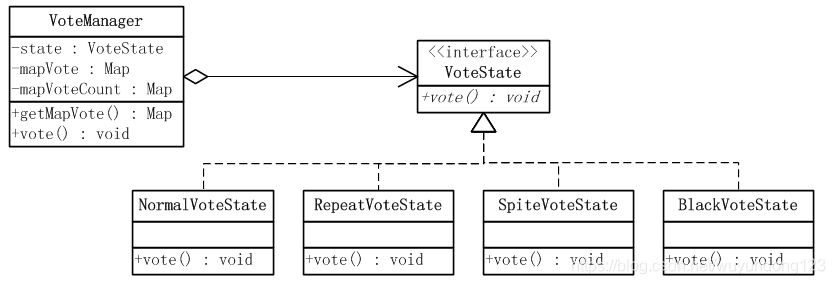java设计模式--状态模式
本文共 4810 字,大约阅读时间需要 16 分钟。
基本概念
状态模式,是对象的行为模式;
状态模式允许一个对象在其内部状态改变的时候改变其行为;这个对象看上去就像是改变了它的类一样;
状态模式的功能就是分离状态的行为,通过维护状态的变化,来调用不同状态对应的不同功能。也就是说,状态和行为是相关联的,它们的关系可以描述为:状态决定行为
基本结构

基本角色
- 环境类(context:里面维护了一个具体状态的实例(AntFarmContext)
- 抽象状态类(state):定义一个接口,封装一些特定的行为(AntFarmState)
- 具体状态类(concreteState):每个子类实现一个与context的一个状态相关的行为(EatingState,InvistorState);
基本代码演示
场景一:在线投票系统的应用
要实现控制同一个用户只能投一票,如果一个用户反复投票,而且投票次数超过5次,则判定为恶意刷票,要取消该用户投票的资格,当然同时也要取消他所投的票;如果一个用户的投票次数超过8次,将进入黑名单,禁止再登录和使用系统;
要使用状态模式实现,首先需要把投票过程的各种状态定义出来,根据以上描述大致分为四种状态:正常投票、反复投票、恶意刷票、进入黑名单。然后创建一个投票管理对象(相当于Context);

抽象状态类:
public interface VoteState { public void vote(String user,String voteItem,VoteManager voteManager);} 具体状态类:
public class NormalVoteState implements VoteState { @Override public void vote(String user, String voteItem, VoteManager voteManager) { voteManager.getMapVote().put(user, voteItem); System.out.println("恭喜投票成功"); }} public class RepeatVoteState implements VoteState { @Override public void vote(String user, String voteItem, VoteManager voteManager) { System.out.println("请不要重复投票"); }} public class SpiteVoteState implements VoteState { @Override public void vote(String user, String voteItem, VoteManager voteManager) { // 恶意投票,取消用户的投票资格,并取消投票记录 String str = voteManager.getMapVote().get(user); if(str != null){ voteManager.getMapVote().remove(user); } System.out.println("你有恶意刷屏行为,取消投票资格"); }} public class BlackVoteState implements VoteState { @Override public void vote(String user, String voteItem, VoteManager voteManager) { System.out.println("进入黑名单,将禁止登录和使用本系统"); }} 环境类:
public class VoteManager { //持有状体处理对象 private VoteState state = null; //记录用户投票的结果,Map 对应Map <用户名称,投票的选项> private Map mapVote = new HashMap (); //记录用户投票次数,Map 对应Map <用户名称,投票的次数> private Map mapVoteCount = new HashMap (); //获取用户投票结果的Map public Map getMapVote() { return mapVote; } public void vote(String user,String voteItem){ //1.为该用户增加投票次数 //从记录中取出该用户已有的投票次数 Integer oldVoteCount = mapVoteCount.get(user); if(oldVoteCount == null){ oldVoteCount = 0; } oldVoteCount += 1; mapVoteCount.put(user, oldVoteCount); //2.判断该用户的投票类型,就相当于判断对应的状态 //到底是正常投票、重复投票、恶意投票还是上黑名单的状态 if(oldVoteCount == 1){ state = new NormalVoteState(); } else if(oldVoteCount > 1 && oldVoteCount < 5){ state = new RepeatVoteState(); } else if(oldVoteCount >= 5 && oldVoteCount <8){ state = new SpiteVoteState(); } else if(oldVoteCount > 8){ state = new BlackVoteState(); } //然后转调状态对象来进行相应的操作 state.vote(user, voteItem, this); }} 客户端测试:
public class Client { public static void main(String[] args) { VoteManager vm = new VoteManager(); for(int i=0;i<9;i++){ vm.vote("u1","A"); } }} 由此可以看出,状态的转换基本上都是内部行为,主要在状态模式内部来维护;比如对于投票的人员,任何时候他的操作都是投票,但是投票管理对象的处理却不一定一样,会根据投票的次数来判断状态,然后根据状态去选择不同的处理;
场景二: 以支付宝蚂蚁庄园为例进行代码演示
未使用状态模式
public class AntFarm { static int eatstate = 0;//表示自己吃饭状态 static int vistitorstate = 1;//表示有访客状态 static int state; public AntFarm() { state = 0;//初始化时小鸡为吃饭状态 } public void invite() { if (state == 0) { System.out.println("邀请别的小鸡"); state = vistitorstate;//状态修改 } else if (state == 1) { System.out.println("已有访客,请勿重复邀请"); } } public void expel() { if (state == 1) { System.out.println("把访客送走"); state = eatstate; } else if (state == 0) { System.out.println("当前没有访客"); } }} 当对象有多种状态的时候再用条件语句显然很不好了,但引入状态模式可以省去条件语句的判断;
使用状态模式
环境类(context):
public class AntFarmContext { AntFarmState state;//持有一个具体状态的实例,不一定是哪种状态 public AntFarmState getState() { return state; } public void setState(AntFarmState state) { this.state = state; } public void invite(){ state.invite();//委托给具体状态类运行 } public void expel(){ state.expel(); }} 抽象状态类(state):
public abstract class AntFarmState { //写这两个方法就是为了子类完成相应操作中重写 public void invite(){ System.out.println("已有访客,请勿重复邀请"); } public void expel(){ System.out.println("当前没有访客"); }} 具体状态类(concreteState):
public class EatingState extends AntFarmState{ AntFarmContext afc; public EatingState(AntFarmContext afc) { this.afc=afc; } public void invite() { System.out.println("邀请别的小鸡"); //执行相应操作后在环境类中更改所处的状态,邀请了小鸡此时给环境类设置访客状态 afc.setState(new InvistorState(afc)); }} public class InvistorState extends AntFarmState{ AntFarmContext afc; public InvistorState(AntFarmContext afc) { this.afc=afc; } public void expel() { System.out.println("把访客送走"); afc.setState(new EatingState(afc)); }} 客户端测试:
public class Client1 { public static void main(String[] args) { AntFarmContext afc=new AntFarmContext(); EatingState es=new EatingState(afc); afc.setState(es);//环境类设置最初状态 afc.invite(); afc.expel(); afc.expel(); afc.invite(); }}
参考文章:
java模式之状态模式:
设计模式之状态模式(state模式):
转载地址:http://fsgtz.baihongyu.com/
你可能感兴趣的文章
Node.js RESTful API如何使用?
查看>>
node.js url模块
查看>>
Node.js Web 模块的各种用法和常见场景
查看>>
Node.js 之 log4js 完全讲解
查看>>
Node.js 函数是什么样的?
查看>>
Node.js 函数计算如何突破启动瓶颈,优化启动速度
查看>>
Node.js 切近实战(七) 之Excel在线(文件&文件组)
查看>>
node.js 初体验
查看>>
Node.js 历史
查看>>
Node.js 在个推的微服务实践:基于容器的一站式命令行工具链
查看>>
Node.js 实现类似于.php,.jsp的服务器页面技术,自动路由
查看>>
Node.js 异步模式浅析
查看>>
node.js 怎么新建一个站点端口
查看>>
Node.js 文件系统的各种用法和常见场景
查看>>
Node.js 模块系统的原理、使用方式和一些常见的应用场景
查看>>
Node.js 的事件循环(Event Loop)详解
查看>>
node.js 简易聊天室
查看>>
Node.js 线程你理解的可能是错的
查看>>
Node.js 调用微信公众号 API 添加自定义菜单报错的解决方法
查看>>
node.js 配置首页打开页面
查看>>